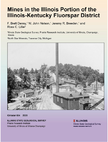| Mines in the Illinois Portion of the Illinois-Kentucky Fluorspar District
|

|
| Series
|
Circular 604
|
| Author
|
F. Brett Denny, W. John Nelson, Jeremy R. Breeden, and Ross C. Lillie
|
| Date
|
2020
|
| Buy
|
Web page
|
| Report
|
PDF file
|
| Map
|
PDF file
|
The following mines and prospects were isolated from the larger subdistricts discussed above and are grouped by general areas. Most produced only small amounts of ore, although a number of these outlying ore deposits were rich in barite.
Mines in the Tower Rock Area
| Alco Mine or Patrick Mine
|
The Alco Mine, also known as the Patrick Mine, was operated by the Alco Lead Company and was located about 3 miles west of Cave-in-Rock. The primary mineral extracted was galena, but a small quantity of fluorite was also recovered (Weller et al. 1952). The main pit was approximately 30 feet deep and trended for approximately 500 feet in a N 45°–50° W direction (Seid et al. 2013a). Northeasterly fractures in the sidewall of the pit are lined with calcite and a small amount of purple fluorite. The pit was less than 30 feet deep and about 70 feet wide according to Ozark-Mahoning file information. The gravel and residuum in the pit are very cherty and moderately high in iron oxides. The mine lies along a small northwest-trending fracture in the St. Louis Limestone (Seid et al. 2013a). Pinckney (1976) reported that the replacement ore at this site wa s predominantly galena and cerussite, with a little fluorite or zinc. Ozark-Mahoning files indicate that a smaller pit, called the Frailey Workings, was present about 1,500 feet southeast of the Patrick Mine (Figure 28). Several prospect pits were aligned in a northwest trend at the Frailey Workings. Several other pits located in this area were found to contain small amounts of fluorspar, galena, or both. Ozark-Mahoning files contain a map and nine-page report describing additional details of these exploration pits. This report indicated that mining in this area began around 1920. A HardinCounty Independent (1934) newspaper article from 1934 stated that a dragline was being used at this mine and had uncovered a vein of “almost pure” galena (p. 1). The article also indicated that more than 1,000 pounds of galena was recovered on the afternoon of September 28.
|
| Palmer Mine
|
The Alco Lead Company mined a small amount of galena at the Palmer Mine, but fluorspar was apparently lacking (Weller et al. 1952). Workings consisted of an open pit about 200 feet long and 100 feet wide and a shaft 40 feet deep. Ozark-Mahoning files indicate that a shaft was sunk in 1942 and that several east–west-trending shallow test pits were dug along the north edge of the property (Weller et al. 1952). Old dumps in this area show very little mineralization (Figure 28).
|
| Tower Rock Mine
|
Jones and Ginn operated the Tower Rock Mine, also known as the Iron Hill Mine. A small amount of fluorspar was extracted from thin veins in a silicified fault zone (Weller et al. 1952).
|
| Hill Mine
|
Bryan and Wallace operated the Hill Mine, which extended about 700 feet along a N 55°–60° E fault zone. The average width of the vein was about 2 feet, and the depths of the shafts were between 12 and 60 feet (Weller et al. 1952). Mineralization was bedding replacement ore that was predominantly fluorspar with moderate amounts of barite along two working levels within the Ste. Genevieve Limestone (Weller et al. 1952).
|
| Winn, Underwood, Rogers, and Frayser Mines
|
The Winn, Underwood, Rogers, and Frayser Mines were located just northeast of Cave-in-Rock along a northeast-trending fault with minor displacement (Seid et al. 2013a). Most of the shafts were shallow (less than 45 feet deep), but the Frayser Shaft extended 110 feet below the surface (Weller et al. 1952). The ore was gravel spar, which resulted from the weathering of fluorspar within the Ste. Genevieve Limestone (Seid et al. 2013a). Weller et al. (1952) surmised that the Rogers Mine was an extension of the Winn orebody.
|
References
- Hardin County Independent, 1934, Oct. 4, p. 1.
|
- Pinckney, D.M., 1976, Mineral resources of the Illinois-Kentucky Fluorspar District: U.S. Geological Survey, Professional Paper 970, 15 p.
|
- Seid, M.J., F.B. Denny, and J.A. Devera, 2013a, Bedrock geology of Cave-in-Rock Quadrangle, Hardin County, Illinois and Crittenden County, Kentucky: Illinois State Geological Survey, USGS-STATEMAP contract report, 2 sheets, 1:24,000; report, 7 p.
|
- Weller, J.M., R.M. Grogan, and F.E. Tippie, 1952, Geology of the fluorspar deposits of Illinois: Illinois State Geological Survey, Bulletin 76, 147 p.
|
Mines enter that are in the Tower Rock Area

